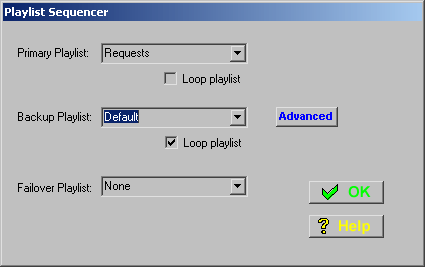
| About |
| Broadcasters |
| Free Trial |
| Purchase |
| News |
| Documentation |
| OAS Audio API |
Interacting with Playout (cont)...
Configuring Playout
Once you have some working scripts (you can test them simply by checking that the tracks are appearing in the required playlist), Playout itself needs to be configured to use the requests.
Configuration is performed through Playout itself via the Playlists, Setup menu. Normally you would specify your overnight, automation list (or the sustaining list) as the Primary Playlist and leave the others unassigned.

To support the requesting concept, you need to set the Primary Playlist to your request list (in this case, Requests) then ensure the Loop playlist button is unchecked - this prevents requests from being continuously repeated. Now specify your normal sustaining list in the Backup Playlist box (in this case, Default).
This means that if there are any unplayed entries available in the Requests list, Playout will load (& play) these, if not it will use your sustaining list instead.
Set the advanced options
This is all very well but there are a number of potential issues and pitfalls with this simple approach - for example, there is nothing to stop two the situation arising where two tracks by the same artist (or even the same track) follow each other. There is also the issue of including jingles and/or adverts at specific intervals. In the later case, you may well have included them as part of your overall sustaining list - all very well but if you have a number of requests stacked up these will all be delayed until the request list is empty.
To solve these issues, you need to setup some rules about how Playout interacts between the two lists and this is controlled via the Advanced button.

This rather daunting dialog addresses all these issues and more:
- This first option (Play 'n' Primary list tracks then 'n' Backup list tracks) allows you to toggle between the two lists. Normally if any tracks are present in the Requests list, they will be played however you may want to include tracks from your sustaining list every so often and this option lets you do this. Leave the option unchecked to assume the default behaviour.
- The Ignore duplicate Artists option solves the issue of tracks by the same artist (and by definition the same track) following each other. Here you can specify an interval of tracks which must be played before one by the same artist is actioned. This has the effect that if 2 tracks by the same artists follow each other in the Request list, the 2nd one will be delayed (using any further requests or the sustaining list as necessary) until the 6 (in the example) other tracks have been played.
- The remaining two options are fairly self explanatory - they allow the insertion of jingles and ad breaks at the specified intervals. There is more information in the online help on setting up the necessary lists which can be selected here. A side effect is that you should now no longer include ads or jingles in your playlists since they will be scheduled in automatically.
Trying it out
Once you've setup the above, it's time to try it out. First, put Playout into auto-sequence mode (Playlists, Start). Assuming no requests are pending, Playout will begin playing out tracks from your normal overnight list. Now make a few requests using your web page and the next time Playout loads a batch of tracks into the system, you should find they are taken from your Request list instead.
Loose end....
There remains really one issue to consider - in order for the scripts to work as shown, their is an assumption that the entire Request list is deleted before you go into the next period of sustained automation - so for Hastings Rock, this would occur just prior to midnight when automation starts. If you don't do this, the rules pertaining to number of artists/tracks per night will carry over to the next sequence.
For Hastings Rock, where the database was hosted on a MySQL server, the solution was straightforward - I simply put together a noddy batch file which ran the necessary SQL to do the delete and scheduled it to run every night just prior to midnight. For an MS-Access solution this is a little more tricky since I'm not aware of any obvious way to achieve this - you may have to write some script to do this yourself or have a trawl on the 'net for something - I can across a program called SQL Batch Executer which may do the job.